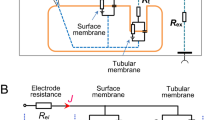Abstract
THE juxtaglomerular granular cell of the kidney is the site of renin storage and release, and is located most commonly within the media of the afferent arteriole, often in close apposition to the distal tubule and to sympathetic nerve endings. Morphologically, it seems to be a smooth muscle cell that has been modified for secretory activity, and contains both myo-fibrils and membrane-limited renin granules1–3. Evidence has accumulated to suggest that the juxtaglomerular cell, either directly or by way of its neighbouring cells, is stimulated to release renin by catecholamines, by changes in intravascular or interstitial pressures, and by variation in local ionic concentrations4. But, even though the juxtaglomerular cell is central to all theories of renin secretion, little effort has been made to investigate its physiology at the cellular level. In this paper, a new method is described for visualising living juxtaglomerular cells, and for recording their electrical activity using intracellular microelectrodes. The results suggest that changes in the membrane potential of the juxtaglomerular cell occur with changes in renin secretion.
Similar content being viewed by others
References
Hatt, P. Y., in Ultrastructure of the Kidney (edit. by Dalton, A., and Haguenau, F.), (Academic, New York, 1967).
Faarup, P., Acta path. microbiol scand., sec. A, suppl. 222, 1–96 (1971).
Page, I., and McCubbin, J., Renal Hypertension (Year Book, Chicago, 1969).
Vander, A., Physiol. Rev., 47, 359–382 (1967).
Mazia, D., Shatten, G., and Sale, W., J. Cell Biol., 66, 198–200 (1975).
Sealy, J., Clark, I., Bull, M., and Laragh, J., J. clin. Invest., 49, 2,119–2,127 (1970).
Vander, A., Am. J. Physiol., 219, 455–459 (1970).
Williams, J., J. theor. Biol., 28, 287–296 (1970).
Michelakis, A., Candle, J., and Liddle, G., Proc. Soc. exp. Biol. Med., 130, 748–753 (1969).
Johns, E., Richards, H., and Singer, B., Br. J. Pharmac., 53, 67–73 (1975).
Rubin, R., Calcium and the Secretory Process (Plenum, New York, 1974).
Bulbring, E., Brading, A., Jones, A., and Tomita, T., Smooth Muscle (Arnold, London, 1970).
Tobian, L., Circulation, 25, 189–192 (1962).
Author information
Authors and Affiliations
Rights and permissions
About this article
Cite this article
FISHMAN, M. Membrane potential of juxtaglomerular cells. Nature 260, 542–544 (1976). https://doi.org/10.1038/260542a0
Received:
Accepted:
Issue Date:
DOI: https://doi.org/10.1038/260542a0
- Springer Nature Limited
This article is cited by
-
Regulation of renin secretion by renal juxtaglomerular cells
Pflügers Archiv - European Journal of Physiology (2013)
-
Lack of direct evidence for a functional role of voltage-operated calcium channels in juxtaglomerular cells
Pfl�gers Archiv European Journal of Physiology (1990)
-
Stimulation of renin secretion by potassium-channel activation with cromakalim
European Journal of Clinical Pharmacology (1989)
-
Signals controlling renin release in aglomerular toadfish
Fish Physiology and Biochemistry (1989)
-
Three-dimensional shape of a Goormaghtigh cell and its contact with a granular cell in the rabbit kidney
Anatomy and Embryology (1982)





